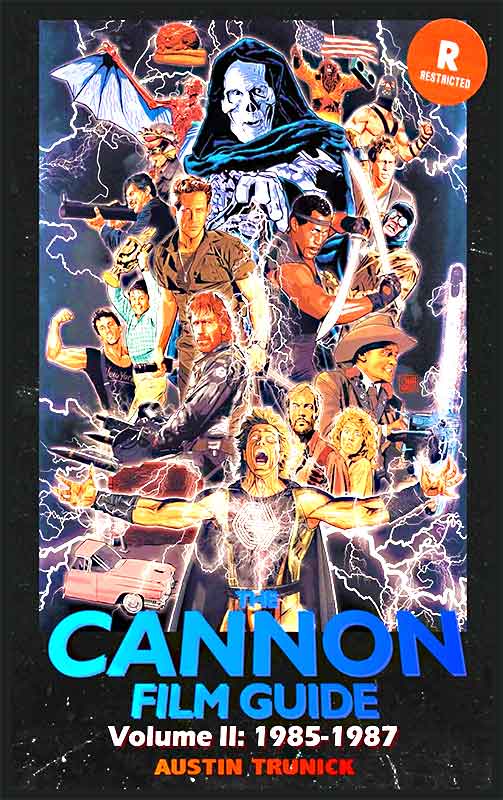 By AUSTIN TRUNICK (BearManor Media; 2021)
By AUSTIN TRUNICK (BearManor Media; 2021)
Anyone who’s read my review of volume one of Austin Trunick’s CANNON FILM GUIDE Volume I will know I’m quite partial to it—or, put another way, I gushed about the book quite shamelessly. Now volume two is here, and guess what? I say it’s even better than its predecessor.
A hefty, profusely illustrated (with VHS covers that, in a most endearing touch, sport visible ex-rental store stickers) book that runs nearly a thousand pages, THE CANNON FILM GUIDE Volume II covers the output of the late Cannon Films during the years 1985-87. It was then that this notoriously scrappy outfit, run by the Israeli shlockmeisters Menahem Golan and Goram Globus, made a bid for Hollywood major status, with would-be blockbusters like LIFEFORCE, INVADERS FROM MARS, OVER THE TOP and SUPERMAN IV: THE QUEST FOR PEACE released alongside (purportedly) respectable fare like FOOL FOR LOVE, STREET SMART and TOUGH GUYS DON’T DANCE, and standard Cannon fodder like RAPPIN’, INVASION U.S.A. and AMERICAN NINJA.
All are covered in these pages, as are little-known obscurities like AMERICA 3000, FIELD OF HONOR and TOO MUCH: THE ROBOT WITH A HEART. All the entries contain extensive background information (proving that even the most worthless movies have a varied history), and in some cases transcribed interviews with cast and crewmembers. Examples of the latter include chats with AMERICAN NINJA breakout Michael Dudikoff, MURPHY’S LAW actress Kathleen Wilhoite, BARFLY director Barbet Schroeder (who clarifies the oft-embellished story of how he threatened to cut off his fingers in order to force Cannon’s hand) and Lucinda Dickey, a pivotal Cannon performer whose work in BREAKIN’, BREAKIN’ 2 and NINJA III: THE DOMINATION was covered quite extensively in the previous volume, but whose personal reflections were saved for this one—meaning any and all Cannon devotees MUST read THE CANNON FILM GUIDE VOLUME II.
All the entries contain extensive background information (proving that even the most worthless movies have a varied history), and in some cases transcribed interviews with cast and crewmembers.
Thankfully that’s not a difficult proposition, as despite its length this book is immensely lively and enjoyable. Trunick has no illusions about the quality of the films he so voluminously covers (he writes that 1987’s THREE KINDS OF HEAT “is a movie. That’s about as much as I can say for it”), films whose sheer awfulness was in large part responsible for Cannon’s inevitable downfall. On MASTERS OF THE UNIVERSE (1987), for instance, we learn that a cash-strapped Golan tried to stop the filming before it was completed, telling director Gary Goddard, “You don’t need to shoot anything else, this is fine” (Goddard ultimately had to partially finance the final days’ filming himself).
Further missteps by Messrs. Golan and Globus included the $270 million purchase of the British Thorn EMI Entertainment outfit in 1986, and the $12 million they gave to Sylvester Stallone to headline OVER THE TOP (which left little money for the making of the film, and kicked off the movie star salary wars that continue to this day). By the end of 1987 Cannon was in bad shape, as evidenced by the fact that the final movie covered here is the aforementioned THREE KINDS OF HEAT, a decidedly inauspicious way to close out the year (and this book). Volume III promises to fill us in on Cannon’s subsequent dissolution, so until then…
